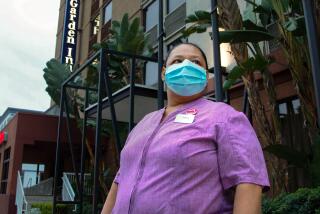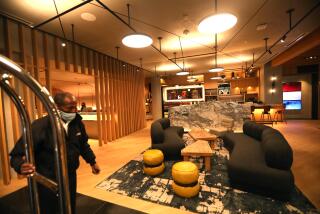Column: A pandemic road trip can mean miles of anxiety. Things to know before you go
The goal was simple and straightforward:
Drive north to Napa Valley from Los Angeles on Interstate 5, work my way back home over three days on the 101, and try to avoid doing anything that might expose me to the coronavirus.
Impossible? Inadvisable? Or simple enough if I played it safe, with a mask over my mug and a cushion of social distance around me?
I had wondered whether to go at all, given the risks. But this wasn’t a contest or an experiment; it was to do the final reporting on a climate change story I’ve been working on.
I ruled out travel by air. Why take the risk of being trapped in a flying capsule and having to deal with the hassles of renting a car? But staying in hotels didn’t hold much appeal, either, in the state with the biggest number of COVID-19 cases.
During the pandemic, a lot of people have opted for motor home rentals over hotels, so I checked out that option. Courtney Leon of El Monte RV told me rental business has increased by three or four times in recent months. She said a 22-foot motel on wheels is now priced at $239 a day, and it sleeps four people comfortably, with a toilet, sink, shower, refrigerator, stove and microwave.
Not bad, but it’s recommended that you rent spots in campgrounds rather than pull over and sleep on the street or in a parking lot, which is illegal in many places and might not be safe. And those campground sites are often booked well in advance.
So I was back to hotels. My editor suggested staying in places where you can open a window to air out the room. Or in places with a wall-mounted air conditioner rather than pumped in recirculated air. I called the photographer I was meeting up with, and he said he’d been staying in hotel chains with coronavirus sanitizing protocols, details of which can be found on the hotel websites.
I booked a room at the Best Western Plus in Calistoga, which says on its website that the chain uses cleaning products recommended by the federal Centers for Disease Control and Prevention. There’s extra emphasis on “door handles, light switches, thermostats, desk areas, hangers, television remotes, alarm clocks, coffee makers, telephones and all bathroom fixture handles and touch points.”
And the chain notes that “the room you stay in will likely not have been used for a period of 24 to 72 hours from the prior guest — a form of social distancing related to the life expectancy of the COVID-19 virus.”
I hit the road Sunday morning with enough fruit, nuts and energy bars to last three days, so I could avoid takeout for breakfast and lunch, another way to limit human contact. I brought a case of bottled water so I could avoid having to refill a reusable container. And I had enough antibacterial wipes, sanitizer and masks to outfit a rural hospital, with goggles, bar soap, a face shield, paper towels and goggles in the trunk.
Heading down the Grapevine, to that great open expanse of the Central Valley, I was reminded that Interstate 5 is the greatest argument for driverless vehicles. The topography is interesting for a while, until you notice that it doesn’t change, and that keeping your eyes open may be the greatest physical challenge of your life.
So you need more coffee, except that more joe means more go, which is a no-no in a pandemic. When the urge first hit, I was determined to wait for a rest area rather than enter a gas station virus chamber, but a man of age gets droopy-eyed on long hauls. I rolled down the windows, blasted a Sunday preacher on the radio and slowly recited 10 Hail Marys. Faith got me to the Buttonwillow rest area, which was temporarily closed, so I cursed.
The Coalinga-Avenal rest stop was another 60 miles up the road, which seemed as far off as a reliable vaccine, but I made it in the nick of time.
I made it to Calistoga in seven hours and checked into my hotel, asking the clerk — who was masked in a plexiglass bunker — if indeed the rooms were kept vacant for 24 to 72 hours between guests. She said no, not necessarily. That was a little disconcerting, but what could I do? The place seemed clean and orderly, and there was a seal on my door signifying the room had been sanitized.
After opening the door, I washed my hands, set my keys, phone and pocket change down on a counter, then wondered if that was safe, so I washed the keys, phone and pocket change, put them on a towel, then flipped a light switch, which made me think I should wash the finger that touched the switch, as well as the hand I used to push open the bathroom door.
The room was warm, but it was 95 outside, so opening a window was no good. Should I turn on the wall-mounted air conditioner, or might the last guest have sneezed on it?
Hotel paranoia had set in.
I removed the bedspread and washed my hands. I stretched a clean T-shirt over my pillow. I wrapped tissue around the remote before turning on the TV. Was it OK to breathe, or should I have brought oxygen tanks and scuba gear?
I was somewhat less neurotic the next night at my hotel in Santa Cruz, and maybe even a bit less at my final hotel in Paso Robles. But the constant fear that I was going to touch something with a microscopic droplet of the coronavirus was taxing. Imagine what it would be like to be a housekeeper?
Maria Mora, who cleans 10 rooms a day at a downtown Los Angeles hotel, later told me that she is nervous every time she walks into a room, even though she uses gloves and a mask. Often, the guests are medical staff members from local hospitals who stay in hotels to avoid bringing exposure home, which isn’t exactly reassuring for the people who clean up after them.
“I’m terrified of contracting the virus and coming home with it,” Mora said, telling me she lives with five people, including an asthmatic son. Mora said she cut her weekly schedule from five days to two to minimize the risk, but that means paying the bills has become an even greater challenge.
If you do travel, folks, don’t forget to tip the housekeepers.
A lot of people didn’t seem to find travel in a pandemic as unnerving as I did. I saw a lot of outdoor dining and cars pulling in and out of wine tasting rooms. Linsey Gallagher of Visit Napa Valley said hotel occupancy was near 50% in July, with bigger numbers on weekends. Kathy Janega-Dykes of Visit Santa Barbara said tourism is down about 30% from last year but has been picking up lately.
But I saw way too many people without masks in public spaces, and it’s hard not to think we may be rushing things — which will only lead to another surge and delay the recovery.
If you do venture out and don’t already know this, restrooms are not necessarily open at gas stations, fast-food restaurants or coffee shops. If you see a car pulled off to the side of the road, there’s a good chance it wasn’t so the occupants could take pictures.
I managed, I think, to keep a safe distance from people for three days. And I have to admit that after months of staying near home, it was liberating to be on the road in a state so vast, varied and relentlessly stunning.
It was also a big relief, and felt like a vacation from stress, to get back home.
More to Read
Sign up for Essential California
The most important California stories and recommendations in your inbox every morning.
You may occasionally receive promotional content from the Los Angeles Times.










